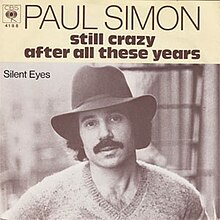Still Crazy After All These Years (song)
| "Still Crazy After All These Years" | ||||
|---|---|---|---|---|
 |
||||
| Single by Paul Simon | ||||
| from the album Still Crazy After All These Years | ||||
| B-side | "I Do It For Your Love" (US) "Silent Eyes" (Europe) |
|||
| Released | March 26, 1976 | |||
| Format | 7" | |||
| Genre | ||||
| Length | 3:24 | |||
| Label | Columbia | |||
| Songwriter(s) | Paul Simon | |||
| Producer(s) |
|
|||
| Paul Simon singles chronology | ||||
|
||||
"Still Crazy After All These Years" is a song by the American singer-songwriter Paul Simon. It was the third and final single from his fifth studio album of the same name (1975), released on Columbia Records. Though the song briefly reached the top 40 of the Billboard Hot 100 in the U.S., it was a bigger hit on the magazine's Easy Listening chart, where it peaked at number four.
"Still Crazy After All These Years" begins with the singer singing that "I met my old lover on the street last night." The "old lover" has been variously interpreted to be either Simon's ex-wife Peggy Harper, from whom he was recently divorced, his former girlfriend from the 1960s Kathy Chitty, or even Simon's former musical partner Art Garfunkel, who appears on the song that follows 'Still Crazy After All These Years" on the album. After sharing a beer, the singer and the old lover part ways again. The singer notes that he is "not the kind of man who tends to socialize" but rather leans "on old familiar ways" and is "still crazy after all these years." The lyrics acknowledge a nostalgia for the past, but also subtly suggest that once the sweet nostalgia is gone, it is replaced by loneliness and even bitterness.
The song features the Muscle Shoals rhythm section: Barry Beckett (Fender Rhodes), David Hood (bass) and Roger Hawkins (drums). The saxophone, played by Michael Brecker, emphasizes the jazz character of the song. Music theorist Peter Kaminsky analyzed how the key progression of the introduction to "Still Crazy After All These Years" anticipates the key progressions throughout the album. The song has an AABA form, with the first, second and fourth verses sharing the same basic melody. The first and second verses are primarily in the key of G major, although there are some unexpected harmonies that differ between the verses. The key of the third verse, the B section, is never resolved. G major returns in the final verse, but modulates to the slightly higher key of A major, which according to author James Bennighof gives "a faint sense of slightly demented triumph to the singer's declaration that he wouldn't be held responsible for his potential mayhem." Music critic Walter Everett considers this modulation to reflect the singer's "unpredictable emotional and mental state."
...
Wikipedia
